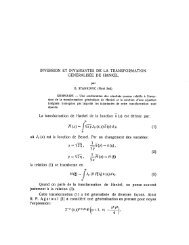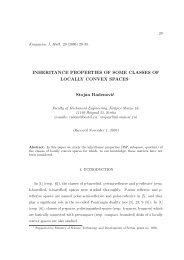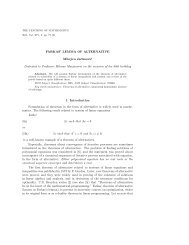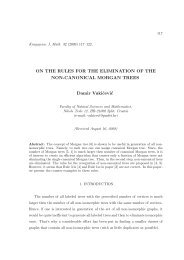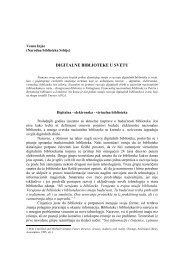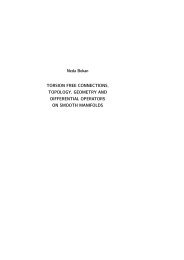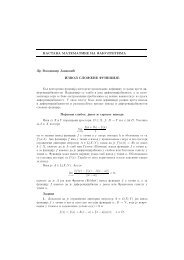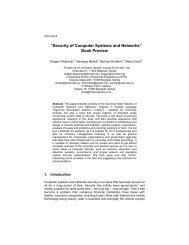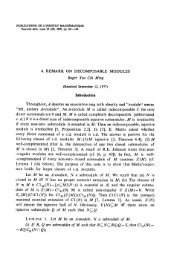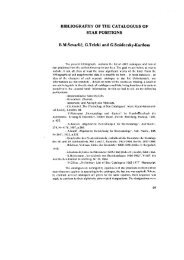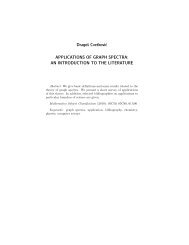based on the example of digital repository BISER
based on the example of digital repository BISER
based on the example of digital repository BISER
Create successful ePaper yourself
Turn your PDF publications into a flip-book with our unique Google optimized e-Paper software.
Senada Dizdar,<br />
Lejla Hajdarpašić<br />
Department <strong>of</strong> Comparative Literature and Librarianship<br />
Faculty <strong>of</strong> Philosophy Sarajevo<br />
Преглед НЦД 19 (2011), 37–44<br />
EDUCATION FOR KNOWLEDGE SOCIETY:<br />
BASED ON THE EXAMPLE OF DIGITAL REPOSITORY <strong>BISER</strong><br />
Abstract: The usage <strong>of</strong> <strong>the</strong> informati<strong>on</strong> and communicati<strong>on</strong> technologies (ICT) in an everyday life,<br />
including <strong>the</strong> field <strong>of</strong> educati<strong>on</strong>, brought <strong>the</strong> need for both thorough and lifel<strong>on</strong>g educati<strong>on</strong>al<br />
reorganizati<strong>on</strong>. It became clear that a standard educati<strong>on</strong>al envir<strong>on</strong>ment, standard library and standard<br />
technological resources can not address at <strong>the</strong> best <strong>the</strong> new requirements that are being put up<strong>on</strong> by <strong>the</strong><br />
need for a new educati<strong>on</strong>. In order to implement <strong>the</strong> educati<strong>on</strong> that is being requested by <strong>the</strong><br />
knowledge society, a new envir<strong>on</strong>ment is needed, <strong>the</strong> <strong>on</strong>e with <strong>the</strong> foundati<strong>on</strong>s in <strong>the</strong> usage <strong>of</strong> modern<br />
ICT, respectively establishing <strong>the</strong> electr<strong>on</strong>ic learning (e-learning) envir<strong>on</strong>ment that implements<br />
learning objects as its foundati<strong>on</strong> entities. As an important place for storing <strong>the</strong> learning objects,<br />
<strong>digital</strong> repositories are emerging, such as <strong>BISER</strong> (Bibliotečki Sarajevski Elektr<strong>on</strong>ski Repozitorij),<br />
which is being used at <strong>the</strong> Faculty <strong>of</strong> Philosophy in Sarajevo, at <strong>the</strong> Department for Comparative<br />
Literature and Librarianship. This papers’ goal is to introduce <strong>the</strong> creati<strong>on</strong> and <strong>the</strong> usage <strong>of</strong> <strong>BISER</strong>, as<br />
a mechanism that enables a systematic handling <strong>of</strong> publishing processes, accessing processes and<br />
processes <strong>of</strong> storing <strong>the</strong> teaching/educati<strong>on</strong>al c<strong>on</strong>tent.<br />
Keywords: virtual learning envir<strong>on</strong>ment, c<strong>on</strong>structive aproach to educati<strong>on</strong>, <strong>BISER</strong> system, lifel<strong>on</strong>g<br />
learning<br />
Introducti<strong>on</strong><br />
The usage <strong>of</strong> <strong>the</strong> informati<strong>on</strong> and communicati<strong>on</strong> technologies (ICT) in an everyday<br />
life, including <strong>the</strong> field <strong>of</strong> educati<strong>on</strong>, brought <strong>the</strong> need for both formal and informal<br />
educati<strong>on</strong>al reorganizati<strong>on</strong>. It has become clear that standard educati<strong>on</strong> envir<strong>on</strong>ment and<br />
standard technological resources (blackboard and chalk) cannot meet at <strong>the</strong> best <strong>the</strong> new<br />
requirements imposed by <strong>the</strong> new envir<strong>on</strong>ment.<br />
In additi<strong>on</strong> to marketing, which necessarily requires changes in educati<strong>on</strong> sector, <strong>the</strong>re<br />
are first generati<strong>on</strong>s <strong>of</strong> students known as "<strong>digital</strong> natives" who also require major changes.<br />
These students grew up in a completely different envir<strong>on</strong>ment surrounded with new<br />
technology which <strong>the</strong>y use from <strong>the</strong> earliest times. Today's students are native speakers <strong>of</strong> <strong>the</strong><br />
<strong>digital</strong> computer languages, video games and <strong>the</strong> Internet (Prensky, 2005). Their world is<br />
different from anything seen so far. Digital natives no l<strong>on</strong>ger need to be in <strong>the</strong> physical space<br />
<strong>of</strong> <strong>the</strong> instituti<strong>on</strong>, but can access informati<strong>on</strong> virtually from any place and at any time. It is<br />
c<strong>on</strong>firmed by research (Prensky, 2005.) that today's students are thinking differently and
38<br />
Senada Dizdar, Lejla Hajdarpašić<br />
processing informati<strong>on</strong> differently. Their demands are different from those which <strong>the</strong>ir<br />
teachers use to have. 1<br />
Inspired by all <strong>the</strong>se demands and <strong>the</strong> progress <strong>of</strong> ICT many projects started with <strong>the</strong><br />
goal <strong>of</strong> creating a str<strong>on</strong>g e-learning community which is oriented towards <strong>the</strong> progress <strong>of</strong> <strong>the</strong><br />
educati<strong>on</strong>al process. New technology changed <strong>the</strong> nature <strong>of</strong> resources that store knowledge.<br />
Creators <strong>of</strong> <strong>digital</strong> envir<strong>on</strong>ment have set a whole range <strong>of</strong> new media and communicati<strong>on</strong><br />
channels. Creati<strong>on</strong> <strong>of</strong> whole new strategy <strong>of</strong> media influences <strong>on</strong> all aspects and people<br />
involved in this process (teachers, students, libraries, administrati<strong>on</strong>). This material needs to<br />
be functi<strong>on</strong>ally and effectively used in accordance with emerging needs. The most important<br />
format <strong>of</strong> storing and managing <strong>the</strong>se materials are <strong>digital</strong> repositories <strong>of</strong> educati<strong>on</strong>al material<br />
that store learning objects or e-learning objects.<br />
In <strong>the</strong> early stages <strong>of</strong> implementing e-learning and creating <strong>digital</strong> repositories,<br />
commercial s<strong>of</strong>tware soluti<strong>on</strong>s have been used. But with <strong>the</strong> development <strong>of</strong> open source<br />
s<strong>of</strong>tware a completely new perspective <strong>of</strong> quick, cheap and mass communicati<strong>on</strong> was created<br />
and was used mostly in academic communities. This has allowed greater involvement <strong>of</strong><br />
universities in <strong>the</strong> e-community.<br />
Usage <strong>of</strong> new technology in educati<strong>on</strong> process raised a new paradigm <strong>of</strong> educati<strong>on</strong><br />
that is oriented towards <strong>the</strong> c<strong>on</strong>structive interpretati<strong>on</strong> <strong>of</strong> educati<strong>on</strong>. This approach explains<br />
that knowledge is not passively received through <strong>the</strong> senses or communicati<strong>on</strong>, but it is<br />
created from an active thinking object (Špiranec, 2007, 15).<br />
C<strong>on</strong>structive Educati<strong>on</strong> Directi<strong>on</strong><br />
Menti<strong>on</strong>ed changes marked <strong>the</strong> c<strong>on</strong>text <strong>of</strong> higher educati<strong>on</strong> in <strong>the</strong> last decade. In <strong>the</strong><br />
educati<strong>on</strong> sector very important knowledge about how to learn and educate in this new way<br />
was achieved. One <strong>of</strong> <strong>the</strong> most influential <strong>the</strong>ories <strong>of</strong> educati<strong>on</strong> comes from <strong>the</strong> fields <strong>of</strong><br />
psychology and thinkers who are active in <strong>the</strong> field <strong>of</strong> cognitive science. The novelty <strong>of</strong> this<br />
approach in relati<strong>on</strong> to <strong>the</strong> former predominantly behaviorist <strong>the</strong>ory is that cognitive oriented<br />
researcher observes learning process as active process <strong>of</strong> students c<strong>on</strong>fr<strong>on</strong>ting with<br />
envir<strong>on</strong>ment.<br />
This <strong>the</strong>ory fosters <strong>the</strong> noti<strong>on</strong> that student develops and expands knowledge in<br />
c<strong>on</strong>structive process. New informati<strong>on</strong> is integrating into <strong>the</strong> existing knowledge, it makes<br />
changes in <strong>the</strong> existing structure <strong>of</strong> knowledge, and (while integrating) gets additi<strong>on</strong>al quality<br />
(Ewert and Thomas, 2001, 56). The process <strong>of</strong> learning can be understood as a c<strong>on</strong>stant<br />
process <strong>of</strong> expansi<strong>on</strong> and organizati<strong>on</strong> <strong>of</strong> knowledge which is frequently represented in <strong>the</strong><br />
following way:<br />
1 So, we have a new generati<strong>on</strong> <strong>of</strong> students who expect:<br />
• recive informati<strong>on</strong> relatively quickly<br />
• do more things at <strong>on</strong>ce<br />
• see first graphics <strong>on</strong> display, and later text<br />
• access informati<strong>on</strong> from any place at any time<br />
• be praised and <strong>of</strong>ten rewarded<br />
• have informati<strong>on</strong> systems that will work like Google.<br />
Introducti<strong>on</strong> text from Marc Prensky: Digital natives, <strong>digital</strong> newcomers, Are you really different?. Edupoint.<br />
February 2005. volume V http://edupoint.carnet.hr/casopis/32/clanci/2 (accessed 25th 3rd 2010.)
Senada Dizdar, Lejla Hajdarpašić 39<br />
Knowledge<br />
Informati<strong>on</strong><br />
Data<br />
Figure1. Pyramidal representati<strong>on</strong> <strong>of</strong> relati<strong>on</strong>s between data, informati<strong>on</strong> and knowledge<br />
This paradigm can be used to show differences between traditi<strong>on</strong>al way <strong>of</strong> learning<br />
(closed paradigm) and c<strong>on</strong>structive access (open paradigm) in educati<strong>on</strong>. Traditi<strong>on</strong>al learning<br />
is understood that a body <strong>of</strong> knowledge which is located outside individual for <strong>example</strong> in <strong>the</strong><br />
textbook or lectures need to be well explained to <strong>the</strong> student. An important determinant <strong>of</strong> this<br />
paradigm is that <strong>the</strong> teacher helps students assimilate and absorb knowledge. New way <strong>of</strong><br />
learning, c<strong>on</strong>structivist learning, explains that educati<strong>on</strong> cannot be reduced to <strong>the</strong> level <strong>of</strong><br />
informati<strong>on</strong> which comes from outside sources, yet it is <strong>on</strong>going and active process <strong>of</strong><br />
c<strong>on</strong>structi<strong>on</strong>. The role <strong>of</strong> educati<strong>on</strong>al media is to engage students in <strong>the</strong> process <strong>of</strong><br />
c<strong>on</strong>structing knowledge. Engagement relates to <strong>the</strong> interpretati<strong>on</strong>, getting insights in <strong>the</strong><br />
various aspects or awareness and training for knowledge management processes. Therefore<br />
<strong>the</strong> recommendati<strong>on</strong>s for designing <strong>the</strong> educati<strong>on</strong>al process, instead <strong>of</strong> <strong>the</strong> traditi<strong>on</strong>al<br />
paradigm <strong>of</strong> knowledge, require from <strong>the</strong> learner to questi<strong>on</strong>, examine, reject or modify <strong>the</strong><br />
c<strong>on</strong>structi<strong>on</strong>s <strong>of</strong> reality. The c<strong>on</strong>structivist movement in didactics fundamentally changes <strong>the</strong><br />
role <strong>of</strong> participati<strong>on</strong>s in educati<strong>on</strong> (in <strong>the</strong> center is <strong>on</strong>e who learns) and seeks to create a new<br />
"learning envir<strong>on</strong>ment" that encourages <strong>the</strong> <strong>on</strong>es who are learning (Špiranec, 2007, 17). From<br />
<strong>the</strong>re we have got complementarity between c<strong>on</strong>structivism and technology models. The role<br />
<strong>of</strong> computer technology is to provide an envir<strong>on</strong>ment for c<strong>on</strong>structive learning process.<br />
However, here it is important to add that no matter how much attenti<strong>on</strong> is currently<br />
focused <strong>on</strong> issues <strong>of</strong> technology in <strong>the</strong> educati<strong>on</strong>al process, educati<strong>on</strong>al comp<strong>on</strong>ent has not<br />
been fully investigated and c<strong>on</strong>sidered and <strong>the</strong>refore we do not know all <strong>the</strong> implicati<strong>on</strong>s and<br />
c<strong>on</strong>sequences <strong>of</strong> <strong>the</strong> introducti<strong>on</strong> <strong>of</strong> technology in educati<strong>on</strong>.<br />
Educati<strong>on</strong>al Process and Informati<strong>on</strong> Sources<br />
Should <strong>the</strong> introducti<strong>on</strong> <strong>of</strong> Web technologies in educati<strong>on</strong>al process experience a<br />
boom will depend <strong>on</strong> <strong>the</strong> availability <strong>of</strong> quality <strong>digital</strong> learning resources. The <strong>digital</strong> age has<br />
changed <strong>the</strong> nature <strong>of</strong> flowing informati<strong>on</strong> sources <strong>the</strong>refore it is justified to speak about <strong>the</strong><br />
evoluti<strong>on</strong> <strong>of</strong> informati<strong>on</strong> sources or informati<strong>on</strong> objects. In order to achieve a clearer<br />
terminology, <strong>the</strong> term informati<strong>on</strong> object (source) needs to be c<strong>on</strong>sidered in relati<strong>on</strong>ship or<br />
correlati<strong>on</strong> with two o<strong>the</strong>r terms: knowledge objects and learning objects. Informati<strong>on</strong> object<br />
is a higher birth term that includes both knowledge objects and learningobjects.
40<br />
Senada Dizdar, Lejla Hajdarpašić<br />
According to Metros and Bennett, it is necessary to distinguish between data,<br />
informati<strong>on</strong> objects and learning objects. An informati<strong>on</strong> object is a <strong>digital</strong> resource <strong>of</strong><br />
informati<strong>on</strong> which does not include an educati<strong>on</strong>al comp<strong>on</strong>ent, such objects are typically<br />
stored in <strong>digital</strong> libraries. Learning objects <strong>on</strong> <strong>the</strong> o<strong>the</strong>r hand include learning objectives and<br />
outcomes, <strong>the</strong>ir assessment and informati<strong>on</strong> object itself.<br />
The model that we have menti<strong>on</strong> before can be used as a beginning step for<br />
interpreting <strong>the</strong> differences between <strong>the</strong>se c<strong>on</strong>cepts, tree level pyramid: data-informati<strong>on</strong>knowledge<br />
can help us track <strong>the</strong> c<strong>on</strong>versi<strong>on</strong> from data into knowledge. Informati<strong>on</strong> objects<br />
are <strong>on</strong> <strong>the</strong> bottom <strong>of</strong> <strong>the</strong> pyramid. Informati<strong>on</strong> objects are comp<strong>on</strong>ent <strong>of</strong> informati<strong>on</strong> or<br />
c<strong>on</strong>tent (it could be any c<strong>on</strong>tent available <strong>on</strong> Web but isolated from o<strong>the</strong>r c<strong>on</strong>tent).<br />
Knowledge objects are <strong>on</strong> <strong>the</strong> top <strong>of</strong> pyramid. Knowledge objects are related to<br />
informati<strong>on</strong> objects that are set in a meaningful way, for <strong>example</strong> by using standard indexing<br />
languages. Digital knowledge objects in a database are indexed <strong>on</strong> <strong>the</strong> basis <strong>of</strong> certain data<br />
scheme. Learning objects are located in <strong>the</strong> middle. They present knowledge objects that are<br />
c<strong>on</strong>textualized in <strong>the</strong> learning domain. Learning objects include relevant metadata <strong>of</strong> learning<br />
objectives, c<strong>on</strong>tent and activity evaluati<strong>on</strong>. Knowledge objects are different than <strong>the</strong><br />
informati<strong>on</strong> objects because we access knowledge objects from <strong>the</strong> positi<strong>on</strong> <strong>of</strong> agreed<br />
meaning (semantics).<br />
Knowledge<br />
objects<br />
Learning objects<br />
Informati<strong>on</strong> objects<br />
Figure2. Pyramidal representati<strong>on</strong> <strong>of</strong> relati<strong>on</strong>s between informati<strong>on</strong> objects,<br />
learning objects and knowledge objects<br />
Explained from <strong>the</strong> analog envir<strong>on</strong>ment, set <strong>of</strong> books is a set <strong>of</strong> informati<strong>on</strong> objects.<br />
The same books cataloged in <strong>the</strong> library are a collecti<strong>on</strong> <strong>of</strong> knowledge objects. Learning<br />
objects are <strong>the</strong>refore available <strong>on</strong>ly in <strong>the</strong> databases or repositories such as <strong>digital</strong> libraries,<br />
which are indexed with metadata for educati<strong>on</strong>al materials (Špiranec, 2007, 27). So, it is easy<br />
to c<strong>on</strong>clude that <strong>the</strong> creati<strong>on</strong> <strong>of</strong> educati<strong>on</strong>al resources is an important milest<strong>on</strong>e in <strong>the</strong><br />
redefiniti<strong>on</strong>, re-c<strong>on</strong>ceptualizati<strong>on</strong> <strong>of</strong> resources. But <strong>the</strong> creati<strong>on</strong> <strong>of</strong> educati<strong>on</strong>al resources<br />
influences <strong>the</strong> entire educati<strong>on</strong>al process and allows c<strong>on</strong>ceptualist approach to educati<strong>on</strong> to<br />
become more present in <strong>the</strong> wider academic community. This testifies <strong>the</strong> implementati<strong>on</strong> <strong>of</strong><br />
system that supports learning at University in Sarajevo: <strong>BISER</strong> (Sarajevo University Library<br />
Electr<strong>on</strong>ic Repository). The distance learning system <strong>BISER</strong> is found <strong>on</strong> open source<br />
s<strong>of</strong>tware called Moodle. Moodle was chosen because <strong>of</strong> his n<strong>on</strong>-commercial basis, but also<br />
because Moodle successfully adjusts to educati<strong>on</strong> processes in educati<strong>on</strong>al instituti<strong>on</strong>s around<br />
<strong>the</strong> world.
Senada Dizdar, Lejla Hajdarpašić 41<br />
Open Source Models<br />
<strong>BISER</strong> is a system for distance learning which has been found <strong>on</strong> <strong>the</strong> system for<br />
managing <strong>on</strong>line learning (LSE, Learning Management System) called MOODLE 2 (Modular<br />
Object-Oriented Dynamic Learning Envir<strong>on</strong>ment).<br />
Moodle is designed as compatible, flexible system. It is programmed in <strong>the</strong> PHP<br />
language that can be installed and run <strong>on</strong> any computer platform. It is designed in a very<br />
modular way, it is a flexible and fast tool. It supports two bases: MySQL and PostgreSQL,<br />
and includes a large number <strong>of</strong> languages. Simple and quick installati<strong>on</strong> gave this tool great<br />
popularity. System itself has low demands and it is easily to integrate it into existing systems.<br />
It is particularly important to stress out that <strong>the</strong> use <strong>of</strong> this soluti<strong>on</strong> is very easy even<br />
for n<strong>on</strong>-informatics. That suggests that <strong>the</strong> organizati<strong>on</strong>al and social challenges are greater<br />
than <strong>the</strong> technical <strong>on</strong>es. This moment is additi<strong>on</strong>ally important since <strong>the</strong> use or installati<strong>on</strong> <strong>of</strong><br />
Moodle system does not require huge financial investments. Deciding to use this system for elearning<br />
purposes is actually an evidence <strong>of</strong> recognizing opportunities that can raise educati<strong>on</strong><br />
process into a new level <strong>of</strong> quality.<br />
Moodle is acr<strong>on</strong>ym for Modular Object-Oriented Dynamic Learning Envir<strong>on</strong>ment that<br />
is most beneficial to programmers and educati<strong>on</strong> <strong>the</strong>orists. Additi<strong>on</strong>ally it is <strong>the</strong> verb that<br />
describes <strong>the</strong> process <strong>of</strong> wiggling or lazy meandering through something, thought that<br />
frequently leads to creative soluti<strong>on</strong>s or comprehensi<strong>on</strong>s.<br />
Creator <strong>of</strong> this applicati<strong>on</strong> is Martin Dougimas, network administrator <strong>of</strong> Curtin<br />
University in Australia. Today this applicati<strong>on</strong> is used to maintain a distance educati<strong>on</strong><br />
worldwide. Moodle as open-source project provides an insight into <strong>the</strong> source code <strong>the</strong>refore<br />
it is possible to modify <strong>the</strong> applicati<strong>on</strong> or to adapt it to own needs. The s<strong>of</strong>tware holds GNU<br />
GPL license and <strong>the</strong> fact that it is possible to use it without compensati<strong>on</strong> c<strong>on</strong>tributed to his<br />
great popularity and c<strong>on</strong>tinued development.<br />
Moodle provides to teachers and associates full computer support in organizati<strong>on</strong>,<br />
planning activities and executi<strong>on</strong> <strong>of</strong> <strong>on</strong>line courses, and is particularly effective as a<br />
supplement to traditi<strong>on</strong>al teaching in <strong>the</strong> classroom (so called blended learning). Creati<strong>on</strong> <strong>of</strong><br />
large number <strong>of</strong> courses in <strong>on</strong>e unique system allows development <strong>of</strong> dynamic <strong>on</strong>line<br />
communities. The courses are shaped and developed by teachers or assistants. Resources are<br />
generally all files, folders, links, all prepared educati<strong>on</strong>al c<strong>on</strong>tents, electr<strong>on</strong>ically available<br />
resources that represent a curriculum structure provided for each course (by <strong>the</strong> choice <strong>of</strong><br />
teachers and /or associates).<br />
All files that are entered into <strong>the</strong> system can be easily copied, modified, deleted, and<br />
compressed using a special module for managing files (File Manager). Websites can be<br />
created with tools that are specifically provided for that purpose. Teachers or associates have<br />
administrative license for specific course. That means when posting c<strong>on</strong>tents <strong>on</strong> <strong>the</strong> system<br />
copyright protecti<strong>on</strong> is an important comp<strong>on</strong>ent <strong>of</strong> correct usage <strong>of</strong> applicati<strong>on</strong>s for distance<br />
learning. Moodle <strong>of</strong>fers several types <strong>of</strong> course structures but three most important are: a<br />
<strong>the</strong>matic form (Topics Format) - units are arranged in <strong>the</strong> form <strong>of</strong> topics (topics are not<br />
specified, teacher marks a special <strong>the</strong>me that is currently being processed); Weekly Format –<br />
units are deployed weekly (<strong>the</strong> system itself accounts dates <strong>of</strong> weeks, depending <strong>on</strong> <strong>the</strong><br />
2 LMS (Learning Management System) and LCMS (Learning C<strong>on</strong>tent Management System) is a complete<br />
soluti<strong>on</strong> for learning system which covers <strong>the</strong> registrati<strong>on</strong> <strong>of</strong> users, <strong>the</strong>ir m<strong>on</strong>itoring, provisi<strong>on</strong> <strong>of</strong> materials to<br />
users and allows <strong>the</strong> verificati<strong>on</strong> <strong>of</strong> knowledge, ensures data security and allows administrators to define access<br />
levels for each individual user.
42<br />
Senada Dizdar, Lejla Hajdarpašić<br />
starting date <strong>of</strong> <strong>the</strong> course, and specifically indicates <strong>the</strong> current week), and social form<br />
(Social Format) - <strong>the</strong> entire course is c<strong>on</strong>ducted in <strong>the</strong> form <strong>of</strong> forums - discussi<strong>on</strong> group.<br />
Especially useful is <strong>the</strong> possibility <strong>of</strong> giving tasks to students, accepting term papers,<br />
giving <strong>on</strong>line tests 3 or possibility <strong>of</strong> sending alerts to all participants <strong>of</strong> <strong>the</strong> course. Electr<strong>on</strong>ic<br />
communicati<strong>on</strong> via forums, email or chat allows users permanent access because all resources<br />
are put into electr<strong>on</strong>ic form. Students can choose <strong>the</strong>ir own "learning paths" or ways that wish<br />
to go though courses. Moodle also <strong>of</strong>fers <strong>the</strong> opti<strong>on</strong> for making backups.<br />
A effective <strong>example</strong> <strong>of</strong> all menti<strong>on</strong>ed before is <strong>BISER</strong> .<br />
<strong>BISER</strong> – <strong>example</strong> <strong>of</strong> good practice<br />
The starter and developer <strong>of</strong> <strong>BISER</strong> system for distance learning is <strong>the</strong> Department <strong>of</strong><br />
Comparative Literature and Librarianship at <strong>the</strong> Faculty <strong>of</strong> Philosophy, University <strong>of</strong><br />
Sarajevo. Implementati<strong>on</strong> <strong>of</strong> distance learning system is <strong>the</strong> result <strong>of</strong> l<strong>on</strong>g-standing successful<br />
cooperati<strong>on</strong> with <strong>the</strong> Department <strong>of</strong> Library and Informati<strong>on</strong> Science at University <strong>of</strong> Zagreb.<br />
Figure3. <strong>BISER</strong> virtual learning envir<strong>on</strong>ment<br />
Within <strong>the</strong> Basileus Erasmus Mundus (2009.) project, department has hosted several<br />
speakers from <strong>the</strong> Department <strong>of</strong> Informati<strong>on</strong> Science, Faculty <strong>of</strong> philosophy, University <strong>of</strong><br />
Zagreb. During <strong>the</strong> <strong>on</strong>e m<strong>on</strong>th stay at our department <strong>the</strong>y helped <strong>the</strong> creati<strong>on</strong> and<br />
implementati<strong>on</strong> <strong>of</strong> <strong>digital</strong> <strong>repository</strong> <strong>BISER</strong>. The implementati<strong>on</strong> begun in February 2009.<br />
Our Faculty does not possess high-quality ICT infrastructure so we agreed that <strong>the</strong> entire<br />
3 Here is important to emphasize that Moodle does not provide <strong>on</strong>e hundred percent user identificati<strong>on</strong> and<br />
although technically possible is not recommended for final tests, but ra<strong>the</strong>r for <strong>on</strong>going verificati<strong>on</strong> activities <strong>of</strong><br />
students through <strong>on</strong>line assignments during <strong>the</strong> semester.
Senada Dizdar, Lejla Hajdarpašić 43<br />
system <strong>BISER</strong> needs to be located <strong>on</strong> <strong>the</strong> server at Faculty <strong>of</strong> Philosophy in Zagreb. <strong>BISER</strong><br />
<strong>of</strong>ficially became active <strong>on</strong> March 18 th , 2009. 4<br />
After s<strong>of</strong>tware installati<strong>on</strong> introductory presentati<strong>on</strong>s for teachers and students were<br />
organized. Because <strong>of</strong> complex user interfaces and various opti<strong>on</strong>s that system <strong>of</strong>fers separate<br />
workshops for teachers were organized. The next step was to organize more courses during<br />
<strong>the</strong> summer semester. Part <strong>of</strong> courses were organized to a similar model like those in Zagreb<br />
instituti<strong>on</strong>s, while o<strong>the</strong>rs are organized by teachers <strong>the</strong>mselves.<br />
The usage statistics <strong>of</strong> <strong>BISER</strong><br />
Within a short period (March 2009. till May 2009.) during <strong>the</strong> test phase, system included<br />
four secti<strong>on</strong>s with <strong>the</strong> Faculty <strong>of</strong> Filosophy in Sarajevo:<br />
- Department <strong>of</strong> Comparative Literature and Librarianship,<br />
- Department <strong>of</strong> Slavic Languages and Literature,<br />
- Department <strong>of</strong> Bosnian, Croatian and Serbian language and<br />
- Department <strong>of</strong> Literature <strong>of</strong> Peoples <strong>of</strong> Bosnia and Herzegovina.<br />
The evaluati<strong>on</strong> which was made after a <strong>on</strong>e year period provides <strong>the</strong> following<br />
informati<strong>on</strong>:<br />
- 139 users<br />
- 18 teacher / assistants<br />
- 26 <strong>on</strong>line courses (some <strong>of</strong> <strong>the</strong> exists <strong>on</strong>ly <strong>on</strong>line)<br />
- about 1GB (955 KB) course materials.<br />
Figure4.Usage statistics<br />
4 In creating and implementing <strong>the</strong> <strong>BISER</strong> pr<strong>of</strong>. dr. Jadranka Lasic-Lazic, Mihaela Banek Zorica, and Jasmin<br />
Klindžić participated. They have already implemented <strong>the</strong> Omega system for distance learning <strong>on</strong> Faculty <strong>of</strong><br />
Philosophy, University <strong>of</strong> Zagreb, which was achieved under <strong>the</strong> project OIZEOO Ministry <strong>of</strong> Educati<strong>on</strong>,<br />
Science and Sport. As a technical basis <strong>the</strong> system uses FLOSS soluti<strong>on</strong> mood. OMEGA system for distance<br />
learning can be found at http:/omega.ffzg.hr (7.5.2010).
44<br />
Senada Dizdar, Lejla Hajdarpašić<br />
Interviews accomplished with students have indicated satisfacti<strong>on</strong> with using <strong>the</strong><br />
system and gave improvement in <strong>the</strong>ir educati<strong>on</strong>al envir<strong>on</strong>ment. The Usage statistics in<br />
Figure 4. indicates that students are regularly visiting <strong>the</strong> system. These numbers are a good<br />
indicator <strong>of</strong> <strong>BISER</strong> success, but still <strong>the</strong>re is a lot <strong>of</strong> work that needs to be d<strong>on</strong>e.<br />
The future step should be integrati<strong>on</strong> with o<strong>the</strong>r important elements <strong>of</strong> educati<strong>on</strong>al<br />
process such as <strong>the</strong> faculty library. Cooperati<strong>on</strong> with <strong>the</strong> faculty library will be essential for<br />
creating and maintaining a <strong>digital</strong> <strong>repository</strong> <strong>of</strong> learning materials.<br />
C<strong>on</strong>clusi<strong>on</strong><br />
1. Technology has significantly changed all spheres <strong>of</strong> human activity. In <strong>the</strong> educati<strong>on</strong><br />
sector it has transformed <strong>the</strong> practice <strong>of</strong> European Universities c<strong>on</strong>tributing <strong>the</strong><br />
implementati<strong>on</strong> <strong>of</strong> <strong>the</strong> Bologna process.<br />
2. The implementati<strong>on</strong> <strong>of</strong> new technologies into traditi<strong>on</strong>al learning envir<strong>on</strong>ment has resulted<br />
with <strong>the</strong> creati<strong>on</strong> <strong>of</strong> virtual envir<strong>on</strong>ments and has changed <strong>the</strong> old educati<strong>on</strong> model that<br />
was focused <strong>on</strong> teacher into a new model that has students in its center.<br />
3. The usage <strong>of</strong> technology changed <strong>the</strong> way <strong>of</strong> recording knowledge and shifted <strong>the</strong><br />
boundaries <strong>of</strong> thinking (especially in social and humanities sciences). Combined or hybrid<br />
learning, blended learning appears to be <strong>the</strong> most successful form <strong>of</strong> learning (particularly<br />
in <strong>the</strong> form <strong>of</strong> a system for distance learning).<br />
4. The introducti<strong>on</strong> <strong>of</strong> technology in educati<strong>on</strong> is promoting learning in accordance with <strong>the</strong><br />
needs and demands <strong>of</strong> a new generati<strong>on</strong> <strong>of</strong> students who grow up in a network<br />
envir<strong>on</strong>ment.<br />
5. Implementati<strong>on</strong> <strong>of</strong> <strong>the</strong> <strong>BISER</strong> has enabled <strong>the</strong> appearance <strong>of</strong> <strong>the</strong> Faculty <strong>of</strong> Philosophy,<br />
University <strong>of</strong> Sarajevo in all major e-educati<strong>on</strong> envir<strong>on</strong>ments.<br />
The implementati<strong>on</strong> <strong>of</strong> <strong>the</strong> <strong>BISER</strong>:<br />
- provides major social and educati<strong>on</strong>al role <strong>of</strong> <strong>the</strong> Faculty,<br />
- creates a new communicati<strong>on</strong> tool for <strong>the</strong> active cooperati<strong>on</strong> <strong>of</strong> teaching staff and<br />
students,<br />
- enables and encourages lifel<strong>on</strong>g learning.<br />
References<br />
[0] <strong>BISER</strong>: Bibliotečki Sarajevski Elektr<strong>on</strong>ski Repozitorij http://biser.ffzg.hr/ (7.5.8.2010.)<br />
[1] Bennett, K., Metros, S. Learning object/module checklist. Educause 2001: The Promise and Pitfalls <strong>of</strong><br />
Learning Objects: Current Status <strong>of</strong> Digital Repositories 10/21/01. http://itc.utk.edu/educause2001–<br />
/checklist.htm Retrieved (23.02.2009.)<br />
[2] Ewert i Thomas, prema Terhart, E. Metode poučavanja i učenja : uvod u probleme metodičke organizacije<br />
poučavanja i učenja . Zagreb : Educa, 2001.<br />
[3] Lasić-Lazić, J., Mihaela Banek-Zorica, Dizdar S., Klindžić, J. Virtual learning spaces: <strong>example</strong> <strong>of</strong><br />
internati<strong>on</strong>al collaborati<strong>on</strong> // 2. međunarodna znanstvena k<strong>on</strong>ferencija “The Future <strong>of</strong> Informati<strong>on</strong> Sciences:<br />
INFutire 2009 str. 511-521<br />
[4] Moodle - A Free, Open Source Course Management System for Online Learning.<br />
[5] http://moodle.org/ (7.5.8.2010.)<br />
[6] OMEGA sustav učenja na daljinu http://omega.ffzg.hr (7.5.8.2010.)<br />
[7] Špiranec, S<strong>on</strong>ja. Model organizacije informacija u elektr<strong>on</strong>ičkoj obrazovnoj okolini. Zagreb : Odsjek za<br />
informacijske znanosti, 2007. (doktorska disertacija u rukopisu )<br />
[8] Wyles, R. Evaluati<strong>on</strong> <strong>of</strong> Learning Management System s<strong>of</strong>tware: Part II <strong>of</strong> LMS Evaluati<strong>on</strong>. March 2004.<br />
https://eduforge.org/docman/view.php/7/17/Evaluati<strong>on</strong>%20<strong>of</strong>%20LMS%20%20Part%20II.pdf (7.5.8.2010.)<br />
senadadizdar@gmail.com<br />
lejla.hajdarpasic83@gmail.com



